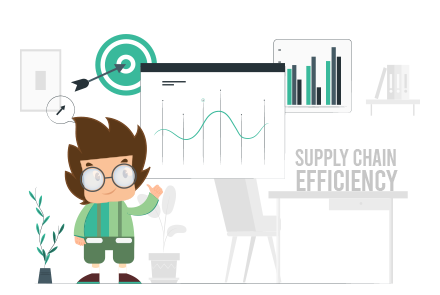Best Strategies to Improve Supply Chain Efficiency
6 minutes reading
Creating a useful supply chain strategy is crucial for any business, as markets are constantly changing, companies cannot address challenges without a plan in place to make their supply chains more flexible and more efficient.
It is how to make balance between efficiency, simplicity, and overarching business requirements.
What Is a Supply Chain Strategy?
In general, a supply chain strategy is a plan used to manage supply chain processes and improve every stage including the sourcing of raw materials, manufacturing, warehousing, shipping, and logistics.
It is a formal approach to meet the goals of the organization in optimizing supply chain capabilities while also keeping costs down, gaining competitive advantage, and being able to meet customer demand on time at the right amount and in the right place.
4 Types of Supply Chain Strategies
1- Customer-centricity
In this approach, the supply chain managers focus on how to give the final client what he needs in the right way, it is about the balance of how to provide the customer the right product at the right place for the right price in a timely manner.
In other words, it is not necessary to be the lower price, or the most advanced product. It is just about suitability for the customer, giving him the quality, availability, and the right price.
Implementing this strategy needs a collaboration between supply chain partners, personnel and financial resources to be motivated, and trained in alignment with the needs serving the supply chain end-user customer which is the primary driver of supply chain decisions.
2- forecast-driven
The second one of supply chain strategies is the forecast-driven approach, without having an understanding of the future, supply chain planning is almost impossible.
Usually, organizations use forecasting as one of the ways to keep pace with rapid change and growing complexity.
It is to see what is coming before it happens in order to make better decisions and predictions, but the visibility of itself gives you a little value unless you use real data and research then act on it.
Why is supply chain forecasting important?
Simply, it is an essential aspect in supply chain management (link to supply chain management blog), actually, it ensures a business continues to grow and flourish as it involves making predictions on all aspects of the supply chain using data and research.
Depending on the size of a business, there are several methods in the supply chain forecasting that meet each of your needs.
Supply chain forecasting often relates to demand forecasting, but it is hard to run supply chain operations without forecasting in place, it enables brands to predict product pricing trends, labor needs, and more.
3- Demand-driven
The next strategy we will talk about is Demand-driven, in this approach, organizations use special tools and technologies based on data to predict demand, it is simply replacing the forecasts with actual demand information.
In the demand-driven model, the supply chain is planned, driven, and executed depending on the customer-demand.
In other words, the process of production is based on sales information, and is turned out only in response to actual orders.
Supply chain managers use different methods such as customers’ survey, social media monitoring, trends and others to collect and analyze customer and market data in the purpose of making better decisions about which products must be created for orders.
Using such a strategy can improve supply chain processes, reduce costs, and increase customer satisfaction.
4- Different Supply Chains
The last strategy is having different supply chains for one company.
You may have many types of products, or you may bring raw materials from many suppliers, or these goods may range from low-priced to sophisticated materials.
products are broken into three categories as Jonathan Byrnes, a professor at MIT, said: staples, seasonal products, and fashion.
Staples have low margins and year-round demand.
Seasonal products have more predictable demand as it is tied to the holiday season.
Fashion products have unpredictable demand, for example, Zara has two supply chains, one for staples and the other for fashion clothing.
List of Effective Supply Chain Strategies
1- Improve Your Supplier Relationships
A healthy supply chain begins with healthy supplier relationships, as it is the first process in the supply chain and logistics.
Make sure to build, improve and maintain good relationships with your suppliers and choose reliable ones.
building good relationships include:
- Communication
A good supplier business owner relationship based on responsivity, and easily understanding.
As a business owner, you should ask yourself, how much is the effectiveness of your communication with your suppliers?
Good suppliers should be responsive for any change that happens with you avoiding you from any loss your business may face.
- Reliability
Reliability is a must-have thing to be at your suppliers. If your suppliers fail to follow their promises in any way, or ship orders late, it may negatively affect your supply chain.
Finding alternative suppliers that have proven to be reliable and can meet your needs is a quick way to enhance your supply chain.
- Speed
Speed is another value you should look for when dealing with your suppliers. In order to boost your supply chain efficiency, you should consider how fast your suppliers can complete your orders.
2- Boost Your Distribution Network
There are two approaches to enhance your distribution network, these are:
- Holistic Approach
This approach may involve reviewing the essential components of the distribution network, as well as it focuses on understanding how these components work at once.
- Cluster Approach
Gathering graphs, charts, and documents together to observe the processes for any specific business function.
3- Analyze Your Supply Chain Strategy
When choosing your supply chain strategy, make sure it is resilient, dependable, cost-efficient, and clear for efficient operations.
Successful supply chain strategy is the one that is appropriate for business type, and aligns with the company’s core goals.
4- Use Demand Forecasting
Using previous demand data to forecast customer demand for your products can optimize your supply chain efficiency.
It is all about reducing costs and increasing customer satisfaction.
5- Monitor Your System
The other strategic solution you should do to boost your supply chain efficiency is to monitor your system.
take a look at the recent performance of your supply chain, check the unfulfilled orders, late shipment, products with inconsistent quality. If so, try to figure out your issues whether it is a 3PL provider, a supplier, or an incorrect process of warehousing.
Once you identify where your issues are coming from, you can implement the right action to improve your supply chain.
It could be trying to switch to different suppliers, trying out a new service of shipping, and so on.
6- Embrace Technology
Another solution to boost your supply chain is to use technology. Powerful emerging technologies allow savvy businesses to present a competitive advantage and identify the areas where technology can improve the processes.
The right technology can reduce the chance for human errors and make your supply chain streamlined, visible, and accessible.
Conclusion
As supply chains have become more complex because of rapid change and complicated global markets, supply chain strategies have come into the spotlight to overcome any supply chain disruption.
Unfortunately, you need to align your strategy to be in tandem with your business goals.
The main purpose of supply chain strategies is to increase revenue, improve customer satisfaction and be globally competitive.
If your strategy does so, then you have a robust one that can make your business go a long way toward growing and flourishing.




Recent Comments